Building Information Modeling (BIM) Driven Carbon Emission Reduction Research: A 14-Year Bibliometric Analysis
Abstract
:1. Introduction
2. Materials and Methods
3. Results
3.1. Number of Publications and Sources of Publications in the Field of Building Information Modeling (BIM), Carbon Emissions, and Sustainable Buildings
3.2. Results of Macroquantitative Analysis
3.2.1. Network Visualization of BIM in the Field of Carbon Emissions for Sustainable Buildings
3.2.2. CiteSpace Keyword-Burst Detection
3.3. Microqualitative Analysis
4. Discussion
4.1. BIM Research Hotspots and Development Trends on Carbon Emissions within the Context of Sustainable Buildings
4.2. Challenges for the Use of BIM in Managing Carbon Emissions for Sustainable Buildings
5. Conclusions
Author Contributions
Funding
Institutional Review Board Statement
Informed Consent Statement
Data Availability Statement
Acknowledgments
Conflicts of Interest
References
- Wang, G.; Li, S.; Yang, L. Research on the Pathway of Green Financial System to Implement the Realization of China’s Carbon Neutrality Target. Int. J. Environ. Res. Public Health 2022, 19, 2451. [Google Scholar] [CrossRef] [PubMed]
- United Nations Framework Convention on Climate Change Adoption of the Paris Agreement: FCCC/CP/2015/L.9/Rev.1. 2015. Available online: http://unfccc.int/resource/docs/2015/cop21/eng/l09r01.pdf (accessed on 18 August 2022).
- IPCC Special Report on Global Warming of 1.5 °C Cambridge University Press, Cambridge and New York. 2018. Available online: https://www.ipcc.ch/sr15/ (accessed on 18 August 2022).
- Wang, N.; Satola, D.; Wiberg, A.; Liu, C.; Gustaysen, A. Reduction Strategies for Greenhouse Gas Emissions from High-Speed Railway Station Buildings in a Cold Climate Zone of China. Sustainability 2020, 12, 1704. [Google Scholar] [CrossRef] [Green Version]
- Yang, J. Editorial: Promoting Integrated Development for Smart and Sustainable Built Environment. Smart Sustain. Built Environ. 2012, 1, 4–13. [Google Scholar] [CrossRef]
- Wu, H.J.; Yuan, Z.W.; Zhang, L.; Bi, J. Life Cycle Energy Consumption and CO2 Emission of an Office Building in China. Int. J. Life Cycle Assess. 2012, 17, 105–118. [Google Scholar] [CrossRef]
- Balasubramanian, S.; Shukla, V.; Islam, N.; Manghat, S. Construction Industry 4.0 and Sustainability: An Enabling Framework. IEEE Trans. Eng. Manag. 2021, 1–19. [Google Scholar] [CrossRef]
- Dong, F.; Zhu, J.; Li, Y.; Chen, Y.; Gao, Y.; Hu, M.; Qin, C.; Sun, J. How Green Technology Innovation Affects Carbon Emission Efficiency: Evidence from Developed Countries Proposing Carbon Neutrality Targets. Environ. Sci. Pollut. Res. 2022, 29, 35780–35799. [Google Scholar] [CrossRef] [PubMed]
- Khahro, S.H.; Kumar, D.; Siddiqui, F.H.; Ali, T.H.; Raza, M.S.; Khoso, A.R. Optimizing Energy Use, Cost and Carbon Emission through Building Information Modelling and a Sustainability Approach: A Case-Study of a Hospital Building. Sustainability 2021, 13, 3675. [Google Scholar] [CrossRef]
- Jutraz, A.; Kukec, A.; Otorepec, P.; Lampic, L.; Pohleven, J.; Sandak, J.; Malovrh, K.; Sajn, M.V. Monitoring Environmental and Health Impact Data in BIM Models to Assure Healthy Living Environments. In Proceedings of the Ecaade Sigradi 2019: Architecture in the Age of the 4th Industrial Revolution, Porto, Portugal, 11–13 September 2019; Sousa, J.P., Henriques, G.C., Xavier, J.P., Eds.; Ecaade-Education & Research Computer Aided Architectural Design Europe: Brussels, Belgium, 2019; Volume 2, pp. 287–294. [Google Scholar]
- Khudhair, A.; Li, H.; Ren, G.; Liu, S. Towards Future BIM Technology Innovations: A Bibliometric Analysis of the Literature. Appl. Sci. 2021, 11, 1232. [Google Scholar] [CrossRef]
- 3D Virtual Worlds and the Metaverse: Current Status and Future Possibilities: ACM Computing Surveys: Vol 45, No 3. Available online: https://dl.acm.org/doi/abs/10.1145/2480741.2480751 (accessed on 4 May 2022).
- Wong, J.K.W.; Zhou, J. Enhancing Environmental Sustainability over Building Life Cycles through Green BIM: A Review. Autom. Constr. 2015, 57, 156–165. [Google Scholar] [CrossRef]
- Lu, W.; Tam, V.W.Y.; Chen, H.; Du, L. A Holistic Review of Research on Carbon Emissions of Green Building Construction Industry. Eng. Constr. Archit. Manag. 2020, 27, 1065–1092. [Google Scholar] [CrossRef]
- Najjar, M.; Figueiredo, K.; Palumbo, M.; Haddad, A. Integration of BIM and LCA: Evaluating the Environmental Impacts of Building Materials at an Early Stage of Designing a Typical Office Building. J. Build. Eng. 2017, 14, 115–126. [Google Scholar] [CrossRef]
- Shukra, Z.A.; Zhou, Y. Holistic Green BIM: A Scientometrics and Mixed Review. Eng. Constr. Archit. Manag. 2020, 28, 2273–2299. [Google Scholar] [CrossRef]
- Wu, X.; Peng, B.; Lin, B. A Dynamic Life Cycle Carbon Emission Assessment on Green and Non-Green Buildings in China. Energy Build. 2017, 149, 272–281. [Google Scholar] [CrossRef]
- Lu, K.; Jiang, X.; Tam, V.; Li, M.; Wang, H.; Xia, B.; Chen, Q. Development of a Carbon Emissions Analysis Framework Using Building Information Modeling and Life Cycle Assessment for the Construction of Hospital Projects. Sustainability 2019, 11, 6274. [Google Scholar] [CrossRef] [Green Version]
- Figl, H.; Ilg, M.; Battisti, K. 6D BIM-Terminal: Missing Link for the Design of CO2-Neutral Buildings. In IOP Conference Series: Earth and Environmental Science, Proceedings of the Sustainable Built Environment D-a-Ch Conference 2019 (Sbe19 Graz), Graz, Austria, 11–14 September 2019; Passer, A., Lutzkendorf, T., Habert, G., KrompKolb, H., Monsberger, M., Eds.; IOP Publishing Ltd.: Bristol, UK, 2019; Volume 323, p. 012104. [Google Scholar]
- Liu, Z.; Yang, Z.; Osmani, M. The Relationship between Sustainable Built Environment, Art Therapy and Therapeutic Design in Promoting Health and Well-Being. Int. J. Environ. Res. Public Health 2021, 18, 10906. [Google Scholar] [CrossRef]
- Van Eck, N.J.; Waltman, L. VOSviewer Manual 54; Universiteit Leiden: Leiden, The Netherlands, 2020. [Google Scholar]
- Liu, R.; Lin, H.; Zhao, H. Research on Field Characteristics of Shared Earth System Science Data Using Keyword Analysis and Visualization. In Procedia Environmental Sciences, Proceedings of the 2011 3rd International Conference on Environmental Science and Information Application Technology Esiat 2011, Beijing, China, 18–19 June 2011; Wu, Y., Ed.; Elsevier Science BV: Amsterdam, The Netherlands, 2011; Volume 10, pp. 561–567. [Google Scholar]
- Shukla, N.; Merigo, J.M.; Lammers, T.; Miranda, L. Half a Century of Computer Methods and Programs in Biomedicine: A Bibliometric Analysis from 1970 to 2017. Comput. Meth. Programs Biomed. 2020, 183, 105075. [Google Scholar] [CrossRef] [PubMed]
- Gorzen-Mitka, I.; Bilska, B.; Tomaszewska, M.; Kolozyn-Krajewska, D. Mapping the Structure of Food Waste Management Research: A Co-Keyword Analysis. Int. J. Environ. Res. Public Health 2020, 17, 4798. [Google Scholar] [CrossRef] [PubMed]
- Yuan, C.; Li, G.; Kamarthi, S.; Jin, X.; Moghaddam, M. Trends in Intelligent Manufacturing Research: A Keyword Co-Occurrence Network Based Review. J. Intell. Manuf. 2022, 33, 425–439. [Google Scholar] [CrossRef]
- Liu, Z.; Liu, J.; Osmani, M. Integration of Digital Economy and Circular Economy: Current Status and Future Directions. Sustainability 2021, 13, 7217. [Google Scholar] [CrossRef]
- Li, J.; Chen, C. Citespace: Scientific Text Mining and Visualization; Capital University of Economics and Business Press: Beijing, China, 2016; pp. 117–119. [Google Scholar]
- Wen, Q.-J.; Ren, Z.-J.; Lu, H.; Wu, J.-F. The Progress and Trend of BIM Research: A Bibliometrics-Based Visualization Analysis. Autom. Constr. 2021, 124, 103558. [Google Scholar] [CrossRef]
- Van Eck, N.J.; Waltman, L. Citation-Based Clustering of Publications Using CitNetExplorer and VOSviewer. Scientometrics 2017, 111, 1053–1070. [Google Scholar] [CrossRef] [PubMed] [Green Version]
- VOSviewer—Getting Started. Available online: https://www.vosviewer.com/getting-started (accessed on 11 September 2022).
- Kibert, C.J. Sustainable Construction: Green Building Design and Delivery; John Wiley & Sons: Hoboken, NJ, USA, 2016; ISBN 978-1-119-05517-4. [Google Scholar]
- Zhang, Y.; Zhu, Z.; Cui, L. A Study of Effective Application of BIM Technology in Green Building. Agro Food Ind. Hi-Tech 2017, 28, 1512–1514. [Google Scholar]
- Xu, S. Study on environmental performance evaluation of green building based on bim technology. Fresenius Environ. Bull. 2021, 30, 4911–4920. [Google Scholar]
- Jiang, S.; Wang, N.; Wu, J. Combining BIM and Ontology to Facilitate Intelligent Green Building Evaluation. J. Comput. Civ. Eng. 2018, 32, 04018039. [Google Scholar] [CrossRef]
- Jun, H.; Kim, I.; Lee, Y.; Kim, M. A Study on the BIM Application of Green Building Certification System. J. Asian Archit. Build. Eng. 2015, 14, 9–16. [Google Scholar] [CrossRef] [Green Version]
- Jalaei, F.; Jrade, A. Integrating Building Information Modeling (BIM) and LEED System at the Conceptual Design Stage of Sustainable Buildings. Sustain. Cities Soc. 2015, 18, 95–107. [Google Scholar] [CrossRef]
- Jalaei, F.; Jalaei, F.; Mohammadi, S. An Integrated BIM-LEED Application to Automate Sustainable Design Assessment Framework at the Conceptual Stage of Building Projects. Sustain. Cities Soc. 2020, 53, 101979. [Google Scholar] [CrossRef]
- Wei, T.; Chen, Y. Green Building Design Based on BIM and Value Engineering. J. Ambient. Intell. Humaniz. Comput. 2020, 11, 3699–3706. [Google Scholar] [CrossRef]
- Wong, J.; Kuan, K. Implementing “BEAM Plus” for BIM-Based Sustainability Analysis. Autom. Constr. 2014, 44, 163–175. [Google Scholar] [CrossRef]
- Xie, J. Calculation of Carbon Emissions Based on BIM Green Buildings. Agro Food Ind. Hi-Tech 2017, 28, 2526–2529. [Google Scholar]
- Franco, M.; Pawar, P.; Wu, X. Green Building Policies in Cities: A Comparative Assessment and Analysis. Energy Build. 2021, 231, 110561. [Google Scholar] [CrossRef]
- Dalla Mora, T.; Bolzonello, E.; Cavalliere, C.; Peron, F. Key Parameters Featuring BIM-LCA Integration in Buildings: A Practical Review of the Current Trends. Sustainability 2020, 12, 7182. [Google Scholar] [CrossRef]
- Chen, C.; Zhao, Z.; Xiao, J.; Tiong, R. A Conceptual Framework for Estimating Building Embodied Carbon Based on Digital Twin Technology and Life Cycle Assessment. Sustainability 2021, 13, 13875. [Google Scholar] [CrossRef]
- Ansah, M.K.; Chen, X.; Yang, H.; Lu, L.; Lam, P.T.I. Developing an Automated BIM-Based Life Cycle Assessment Approach for Modularly Designed High-Rise Buildings. Environ. Impact Assess. Rev. 2021, 90, 106618. [Google Scholar] [CrossRef]
- Yang, X.; Hu, M.; Wu, J.; Zhao, B. Building-Information-Modeling Enabled Life Cycle Assessment, a Case Study on Carbon Footprint Accounting for a Residential Building in China. J. Clean. Prod. 2018, 183, 729–743. [Google Scholar] [CrossRef]
- Cheng, B.; Li, J.; Tam, V.; Yang, M.; Chen, D. A BIM-LCA Approach for Estimating the Greenhouse Gas Emissions of Large-Scale Public Buildings: A Case Study. Sustainability 2020, 12, 685. [Google Scholar] [CrossRef] [Green Version]
- Kylili, A.; Fokaides, P. Policy Trends for the Sustainability Assessment of Construction Materials: A Review. Sustain. Cities Soc. 2017, 35, 280–288. [Google Scholar] [CrossRef]
- Palumbo, E.; Soust-Verdaguer, B.; Llatas, C.; Traverso, M. How to Obtain Accurate Environmental Impacts at Early Design Stages in BIM When Using Environmental Product Declaration. A Method to Support Decision-Making. Sustainability 2020, 12, 6927. [Google Scholar] [CrossRef]
- Marzouk, M.; Azab, S.; Metawie, M. Framework for Sustainable Low-Income Housing Projects Using Building Information Modeling. J. Environ. Inform. 2016, 28, 25–38. [Google Scholar] [CrossRef] [Green Version]
- Wu, P.; Xia, B.; Zhao, X. The Importance of Use and End-of-Life Phases to the Life Cycle Greenhouse Gas (GHG) Emissions of Concrete—A Review. Renew. Sustain. Energy Rev. 2014, 37, 360–369. [Google Scholar] [CrossRef] [Green Version]
- Kurian, R.; Kulkarni, K.S.; Ramani, P.V.; Meena, C.S.; Kumar, A.; Cozzolino, R. Estimation of Carbon Footprint of Residential Building in Warm Humid Climate of India through BIM. Energies 2021, 14, 4237. [Google Scholar] [CrossRef]
- Meek, A.; Elchalakani, M.; Beckett, C.; Grant, T. Alternative Stabilised Rammed Earth Materials Incorporating Recycled Waste and Industrial By-Products: Life Cycle Assessment. Constr. Build. Mater. 2021, 267, 120997. [Google Scholar] [CrossRef]
- Di Maria, A.; Salman, M.; Dubois, M.; Van Acker, K. Life Cycle Assessment to Evaluate the Environmental Performance of New Construction Material from Stainless Steel Slag. Int. J. Life Cycle Assess. 2018, 23, 2091–2109. [Google Scholar] [CrossRef]
- Muda, Z.; Shafigh, P.; Mahyuddin, N.; Sepasgozar, S.; Beddu, S.; Zakaria, A. Energy Performance of a High-Rise Residential Building Using Fibre-Reinforced Structural Lightweight Aggregate Concrete. Appl. Sci. 2020, 10, 4489. [Google Scholar] [CrossRef]
- Kirschke, P.; Sietko, D. The Function and Potential of Innovative Reinforced Concrete Prefabrication Technologies in Achieving Residential Construction Goals in Germany and Poland. Buildings 2021, 11, 533. [Google Scholar] [CrossRef]
- Li, X.-J.; Lai, J.; Ma, C.; Wang, C. Using BIM to Research Carbon Footprint during the Materialization Phase of Prefabricated Concrete Buildings: A China Study. J. Clean. Prod. 2021, 279, 123454. [Google Scholar] [CrossRef]
- Lu, Y.; Le, V.H.; Song, X. Beyond Boundaries: A Global Use of Life Cycle Inventories for Construction Materials. J. Clean. Prod. 2017, 156, 876–887. [Google Scholar] [CrossRef]
- Zhuang, D.; Zhang, X.; Lu, Y.; Wang, C.; Jin, X.; Zhou, X.; Shi, X. A Performance Data Integrated BIM Framework for Building Life-Cycle Energy Efficiency and Environmental Optimization Design. Autom. Constr. 2021, 127, 103712. [Google Scholar] [CrossRef]
- Starynina, J.; Ustinovichius, L. A multi-criteria decision-making synthesis method to determine the most effective option for modernising a public building. Technol. Econ. Dev. Econ. 2020, 26, 1237–1262. [Google Scholar] [CrossRef]
- Galiano-Garrigos, A.; Garcia-Figueroa, A.; Rizo-Maestre, C.; Gonzalez-Aviles, A. Evaluation of BIM Energy Performance and CO2 Emissions Assessment Tools: A Case Study in Warm Weather. Build. Res. Inf. 2019, 47, 787–812. [Google Scholar] [CrossRef]
- Lee, K.; Choo, S. A Hierarchy of Architectural Design Elements for Energy Saving of Tower Buildings in Korea Using Green BIM Simulation. Adv. Civ. Eng. 2018, 2018, 7139196. [Google Scholar] [CrossRef] [Green Version]
- Singh, P.; Sadhu, A. Multicomponent Energy Assessment of Buildings Using Building Information Modeling. Sustain. Cities Soc. 2019, 49, 101603. [Google Scholar] [CrossRef]
- Cemesova, A.; Hopfe, C.; Mcleod, R. PassivBIM: Enhancing Interoperability between BIM and Low Energy Design Software. Autom. Constr. 2015, 57, 17–32. [Google Scholar] [CrossRef]
- Zhao, L.; Zhang, H.; Wang, Q.; Wang, H. Digital-Twin-Based Evaluation of Nearly Zero-Energy Building for Existing Buildings Based on Scan-to-BIM. Adv. Civ. Eng. 2021, 2021, 6638897. [Google Scholar] [CrossRef]
- Chen, S. Use of green building information modeling in the assessment of net zero energy building design. J. Environ. Eng. Landsc. Manag. 2019, 27, 174–186. [Google Scholar] [CrossRef]
- Kaewunruen, S.; Rungskunroch, P.; Welsh, J. A Digital-Twin Evaluation of Net Zero Energy Building for Existing Buildings. Sustainability 2019, 11, 159. [Google Scholar] [CrossRef] [Green Version]
- Torregrosa-Jaime, B.; Gonzalez, B.; Martinez, P.; Paya-Ballester, G. Analysis of the Operation of an Aerothermal Heat Pump in a Residential Building Using Building Information Modelling. Energies 2018, 11, 1642. [Google Scholar] [CrossRef] [Green Version]
- Petri, I.; Kubicki, S.; Rezgui, Y.; Guerriero, A.; Li, H. Optimizing Energy Efficiency in Operating Built Environment Assets through Building Information Modeling: A Case Study. Energies 2017, 10, 1167. [Google Scholar] [CrossRef] [Green Version]
- Najjar, M.; Figueiredo, K.; Hammad, A.; Haddad, A. Integrated Optimization with Building Information Modeling and Life Cycle Assessment for Generating Energy Efficient Buildings. Appl. Energy 2019, 250, 1366–1382. [Google Scholar] [CrossRef]
- Alhamami, A.; Petri, I.; Rezgui, Y.; Kubicki, S. Promoting Energy Efficiency in the Built Environment through Adapted BIM Training and Education. Energies 2020, 13, 2308. [Google Scholar] [CrossRef]
- Brown, M.; Southworth, F. Mitigating Climate Change through Green Buildings and Smart Growth. Environ. Plan. A 2008, 40, 653–675. [Google Scholar] [CrossRef] [Green Version]
- Ruiz, A.; Guevara, J. Energy Efficiency Strategies in the Social Housing Sector: Dynamic Considerations and Policies. J. Manag. Eng. 2021, 37, 04021040. [Google Scholar] [CrossRef]
- Yang, Z.; Chen, H.; Mi, L.; Li, P.; Qi, K. Green Building Technologies Adoption Process in China: How Environmental Policies Are Reshaping the Decision-Making among Alliance-Based Construction Enterprises? Sustain. Cities Soc. 2021, 73, 103122. [Google Scholar] [CrossRef]
- Adekanye, O.; Davis, A.; Azevedo, I. Federal Policy, Local Policy, and Green Building Certifications in the U.S. Energy Build. 2020, 209, 109700. [Google Scholar] [CrossRef]
- O’Neill, K.; Gibbs, D. Sustainability Transitions and Policy Dismantling: Zero Carbon Housing in the UK. Geoforum 2020, 108, 119–129. [Google Scholar] [CrossRef]
- Shan, M.; Hwang, B.; Zhu, L. A Global Review of Sustainable Construction Project Financing: Policies, Practices, and Research Efforts. Sustainability 2017, 9, 2347. [Google Scholar] [CrossRef] [Green Version]
- Onat, N.; Egilmez, G.; Tatari, O. Towards Greening the U.S. Residential Building Stock: A System Dynamics Approach. Build. Environ. 2014, 78, 68–80. [Google Scholar] [CrossRef]
- Liu, P.; Lin, B.; Zhou, H.; Wu, X.; Little, J. CO2 Emissions from Urban Buildings at the City Scale: System Dynamic Projections and Potential Mitigation Policies. Appl. Energy 2020, 277, 115546. [Google Scholar] [CrossRef]
- Wu, J.; Cui, C.; Mei, X.; Xu, Q.; Zhang, P. Migration of Manufacturing Industries and Transfer of Carbon Emissions Embodied in Trade: Empirical Evidence from China and Thailand. Environ. Sci. Pollut. Res. 2021, 1–13. [Google Scholar] [CrossRef]
- Li, D.; Huang, G.; Zhang, G.; Wang, J. Driving Factors of Total Carbon Emissions from the Construction Industry in Jiangsu Province, China. J. Clean. Prod. 2020, 276, 123179. [Google Scholar] [CrossRef]
- Tan, X.; Lai, H.; Gu, B.; Zeng, Y.; Li, H. Carbon Emission and Abatement Potential Outlook in China’s Building Sector through 2050. Energy Policy 2018, 118, 429–439. [Google Scholar] [CrossRef]
- Chen, Y.; Jiang, P.; Dong, W.; Huang, B. Analysis on the Carbon Trading Approach in Promoting Sustainable Buildings in China. Renew. Energy 2015, 84, 130–137. [Google Scholar] [CrossRef]
- Xie, B.; Zhai, J.; Sun, P.; Ma, J. Assessment of Energy and Emission Performance of a Green Scientific Research Building in Beijing, China. Energy Build. 2020, 224, 110248. [Google Scholar] [CrossRef]
- Ma, M.; Cai, W.; Wu, Y. China Act on the Energy Efficiency of Civil Buildings (2008): A Decade Review. Sci. Total Environ. 2019, 651, 42–60. [Google Scholar] [CrossRef] [PubMed]
- Ma, L.; Le, Y.; Li, H.; Jin, R.; Piroozfar, P.; Liu, M. Regional Comparisons of Contemporary Construction Industry Sustainable Concepts in the Chinese Context. Sustainability 2018, 10, 3831. [Google Scholar] [CrossRef] [Green Version]
- Kleinberg, J. Bursty and Hierarchical Structure in Streams. Data Min. Knowl. Discov. 2003, 7, 373–397. [Google Scholar] [CrossRef]
- Liu, J.; Wang, Y.; Zhang, Q.; Wei, J.; Zhou, H. Scientometric Analysis of Public Health Emergencies: 1994-2020. Int. J. Environ. Res. Public Health 2022, 19, 640. [Google Scholar] [CrossRef] [PubMed]
- Wu, Y.; Wang, H.; Wang, Z.; Zhang, B.; Meyer, B.C. Knowledge Mapping Analysis of Rural Landscape Using CiteSpace. Sustainability 2020, 12, 66. [Google Scholar] [CrossRef] [Green Version]
- Kim, J.; Todorovic, M. Towards Sustainability Index for Healthy Buildings-Via Intrinsic Thermodynamics, Green Accounting and Harmony. Energy Build. 2013, 62, 627–637. [Google Scholar] [CrossRef]
- Migilinskas, D.; Balionis, E.; Dziugaite-Tumeniene, R.; Siupsinskas, G. An advanced multi-criteria evaluation model of the rational building energy performance. J. Civ. Eng. Manag. 2016, 22, 844–851. [Google Scholar] [CrossRef]
- Solla, M.; Ismail, L.H.; Shaarani, A.S.M.; Milad, A. Measuring the Feasibility of Using of BIM Application to Facilitate GBI Assessment Process. J. Build. Eng. 2019, 25, 100821. [Google Scholar] [CrossRef]
- Kang, T. Rule-Based LEED Evaluation Method Considering BIM Linkage and Variability. KSCE J. Civ. Eng. 2020, 24, 110–121. [Google Scholar] [CrossRef]
- Bilal, M.; Khan, K.I.A.; Thaheem, M.J.; Nasir, A.R. Current State and Barriers to the Circular Economy in the Building Sector: Towards a Mitigation Framework. J. Clean. Prod. 2020, 276, 123250. [Google Scholar] [CrossRef]
- Zhou, W.; Kou, A.; Chen, J.; Ding, B. A Retrospective Analysis with Bibliometric of Energy Security in 2000–2017. Energy Rep. 2018, 4, 724–732. [Google Scholar] [CrossRef]
- Barone, G.; Buonomano, A.; Forzano, C.; Giuzio, G.; Palombo, A. Improving the Efficiency of Maritime Infrastructures through a BIM-Based Building Energy Modelling Approach: A Case Study in Naples, Italy. Energies 2021, 14, 4854. [Google Scholar] [CrossRef]
- Haruna, A.; Shafiq, N.; Montasir, O.A. Building Information Modelling Application for Developing (Multi Criteria Decision Making Approach). Ain Shams Eng. J. 2021, 12, 293–302. [Google Scholar] [CrossRef]
- Marzouk, M.; Abdelbasset, I.; Al-Gahtani, K. Evaluating Building Systems Energy Performance Superiority and Inferiority Ranking. J. Environ. Inform. 2021, 38, 56–67. [Google Scholar] [CrossRef]
- Carvalho, J.; Braganca, L.; Mateus, R. Sustainable Building Design: Analysing the Feasibility of BIM Platforms to Support Practical Building Sustainability Assessment. Comput. Ind. 2021, 127, 103400. [Google Scholar] [CrossRef]
- Cang, Y.; Luo, Z.; Yang, L.; Han, B. A New Method for Calculating the Embodied Carbon Emissions from Buildings in Schematic Design: Taking “Building Element” as Basic Unit. Build. Environ. 2020, 185, 107306. [Google Scholar] [CrossRef]
- Carvalho, J.; Braganca, L.; Mateus, R. Optimising Building Sustainability Assessment Using BIM. Autom. Constr. 2019, 102, 170–182. [Google Scholar] [CrossRef]
- Tushar, Q.; Bhuiyan, M.; Sandanayake, M.; Zhang, G. Optimizing the Energy Consumption in a Residential Building at Different Climate Zones: Towards Sustainable Decision Making. J. Clean. Prod. 2019, 233, 634–649. [Google Scholar] [CrossRef]
- Eleftheriadis, S.; Duffour, P.; Greening, P.; James, J.; Stephenson, B.; Mumovic, D. Investigating Relationships between Cost and CO2 Emissions in Reinforced Concrete Structures Using a BIM-Based Design Optimisation Approach. Energy Build. 2018, 166, 330–346. [Google Scholar] [CrossRef]
- Jrade, A.; Jalaei, F. Integrating Building Information Modelling with Sustainability to Design Building Projects at the Conceptual Stage. Build. Simul. 2013, 6, 429–444. [Google Scholar] [CrossRef]
- Rebitzer, G. Integrating Life Cycle Costing and Life Cycle Assessment for Managing Costs and Environmental Impacts in Supply Chains. In Cost Management in Supply Chains; Springer: Berlin/Heidelberg, Germany, 2002; pp. 127–146. [Google Scholar] [CrossRef]
- Bank, L.; Thompson, B.; McCarthy, M. Decision-Making Tools for Evaluating the Impact of Materials Selection on the Carbon Footprint of Buildings. Carbon Manag. 2011, 2, 431–441. [Google Scholar] [CrossRef]
- Chen, L.; Pan, W. BIM-Aided Variable Fuzzy Multi-Criteria Decision Making of Low-Carbon Building Measures Selection. Sustain. Cities Soc. 2016, 27, 222–232. [Google Scholar] [CrossRef]
- Xue, K.; Hossain, M.; Liu, M.; Ma, M.; Zhang, Y.; Hu, M.; Chen, X.; Cao, G. BIM Integrated LCA for Promoting Circular Economy towards Sustainable Construction: An Analytical Review. Sustainability 2021, 13, 1310. [Google Scholar] [CrossRef]
- Liu, S.; Meng, X.; Tam, C. Building Information Modeling Based Building Design Optimization for Sustainability. Energy Build. 2015, 105, 139–153. [Google Scholar] [CrossRef]
- Eleftheriadis, S.; Mumovic, D.; Greening, P. Life Cycle Energy Efficiency in Building Structures: A Review of Current Developments and Future Outlooks Based on BIM Capabilities. Renew. Sustain. Energy Rev. 2017, 67, 811–825. [Google Scholar] [CrossRef] [Green Version]
- Marrero, M.; Wojtasiewicz, M.; Martinez-Rocamora, A.; Solis-Guzman, J.; Alba-Rodriguez, M. BIM-LCA Integration for the Environmental Impact Assessment of the Urbanization Process. Sustainability 2020, 12, 4196. [Google Scholar] [CrossRef]
- Eleftheriadis, S.; Duffour, P.; Mumovic, D. BIM-Embedded Life Cycle Carbon Assessment of RC Buildings Using Optimised Structural Design Alternatives. Energy Build. 2018, 173, 587–600. [Google Scholar] [CrossRef]
- Akcay, E.; Arditi, D. Desired points at minimum cost in the “Optimize Energy Performance” credit of leed certification. J. Civ. Eng. Manag. 2017, 23, 796–805. [Google Scholar] [CrossRef]
- Mulero-Palencia, S.; Alvarez-Diaz, S.; Andres-Chicote, M. Machine Learning for the Improvement of Deep Renovation Building Projects Using As-Built BIM Models. Sustainability 2021, 13, 6576. [Google Scholar] [CrossRef]
- Sun, H.; Park, Y. CO2 Emission Calculation Method during Construction Process for Developing BIM-Based Performance Evaluation System. Appl. Sci. 2020, 10, 5587. [Google Scholar] [CrossRef]
- Chen, P.; Nguyen, T. A BIM-WMS Integrated Decision Support Tool for Supply Chain Management in Construction. Autom. Constr. 2019, 98, 289–301. [Google Scholar] [CrossRef]
- Piselli, C.; Guastaveglia, A.; Romanelli, J.; Cotana, F.; Pisello, A.L. Facility Energy Management Application of HBIM for Historical Low-Carbon Communities: Design, Modelling and Operation Control of Geothermal Energy Retrofit in a Real Italian Case Study. Energies 2020, 13, 6338. [Google Scholar] [CrossRef]
- Tzortzopoulos, P.; Ma, L.; Soliman, J.; Koskela, L. Evaluating Social Housing Retrofit Options to Support Clients’ Decision MakingSIMPLER BIM Protocol. Sustainability 2019, 11, 2507. [Google Scholar] [CrossRef] [Green Version]
- Ozarisoy, B.; Altan, H. Low-Energy Design Strategies for Retrofitting Existing Residential Buildings in Cyprus. Proc. Inst. Civ. Eng.-Eng. Sustain. 2019, 172, 241–255. [Google Scholar] [CrossRef]
- Edwards, R.; Lou, E.; Bataw, A.; Kamaruzzaman, S.; Johnson, C. Sustainability-Led Design: Feasibility of Incorporating Whole-Life Cycle Energy Assessment into BIM for Refurbishment Projects. J. Build. Eng. 2019, 24, 100697. [Google Scholar] [CrossRef]
- Piselli, C.; Romanelli, J.; Di Grazia, M.; Gavagni, A.; Moretti, E.; Nicolini, A.; Cotana, F.; Strangis, F.; Witte, H.; Pisello, A. An Integrated HBIM Simulation Approach for Energy Retrofit of Historical Buildings Implemented in a Case Study of a Medieval Fortress in Italy. Energies 2020, 13, 2601. [Google Scholar] [CrossRef]
- Hu, M. Optimal Renovation Strategies for Education BuildingsA Novel BIM-BPM-BEM Framework. Sustainability 2018, 10, 3287. [Google Scholar] [CrossRef] [Green Version]
- Amano, K.; Lou, E.C.W.; Edwards, R. Integration of Point Cloud Data and Hyperspectral Imaging as a Data Gathering Methodology for Refurbishment Projects Using Building Information Modelling (BIM). J. Facil. Manag. 2018, 17, 57–75. [Google Scholar] [CrossRef]
- Guo, K.; Li, Q.; Zhang, L.; Wu, X. BIM-Based Green Building Evaluation and Optimization: A Case Study. J. Clean. Prod. 2021, 320, 128824. [Google Scholar] [CrossRef]
- Kim, S.; Kim, S. Lessons Learned from the Existing Building Energy Optimization Workshop: An Initiative for the Analysis-Driven Retrofit Decision Making. KSCE J. Civ. Eng. 2017, 21, 1059–1068. [Google Scholar] [CrossRef]
- Sattary, S.; Thorpe, D. Potential Carbon Emission Reductions in Australian Construction Systems through Bioclimatic Principles. Sustain. Cities Soc. 2016, 23, 105–113. [Google Scholar] [CrossRef]
- Chen, C.; Tang, L. BIM-Based Integrated Management Workflow Design for Schedule and Cost Planning of Building Fabric Maintenance. Autom. Constr. 2019, 107, 102944. [Google Scholar] [CrossRef]
- Shadram, F.; Mukkavaara, J. An Integrated BIM-Based Framework for the Optimization of the Trade-off between Embodied and Operational Energy. Energy Build. 2018, 158, 1189–1205. [Google Scholar] [CrossRef]
- Costa, A.; Keane, M.; Torrens, J.; Corry, E. Building Operation and Energy Performance: Monitoring, Analysis and Optimisation Toolkit. Appl. Energy 2013, 101, 310–316. [Google Scholar] [CrossRef]
- Gokce, H.; Gokce, K. Holistic System Architecture for Energy Efficient Building Operation. Sustain. Cities Soc. 2013, 6, 77–84. [Google Scholar] [CrossRef]
- Grussing, M.N.; Marrano, L.R. Building Component Lifecycle Repair/Replacement Model for Institutional Facility Management. Comput. Civ. Eng. 2012, 550–557. [Google Scholar] [CrossRef] [Green Version]
- Ramesh, T.; Prakash, R.; Shukla, K.K. Life Cycle Energy Analysis of Buildings: An Overview. Energy Build. 2010, 42, 1592–1600. [Google Scholar] [CrossRef]
- Abu Bakar, N.N.; Hassan, M.Y.; Abdullah, H.; Rahman, H.A.; Abdullah, M.P.; Hussin, F.; Bandi, M. Energy Efficiency Index as an Indicator for Measuring Building Energy Performance: A Review. Renew. Sustain. Energy Rev. 2015, 44, 1–11. [Google Scholar] [CrossRef]
- Iddon, C.; Firth, S. Embodied and Operational Energy for New-Build Housing: A Case Study of Construction Methods in the UK. Energy Build. 2013, 67, 479–488. [Google Scholar] [CrossRef]
- Venkatraj, V.; Dixit, M.K.; Yan, W.; Lavy, S. Evaluating the Impact of Operating Energy Reduction Measures on Embodied Energy. Energy Build. 2020, 226, 110340. [Google Scholar] [CrossRef]
- Shi, Y.; Xu, J. BIM-Based Information System for Econo-Enviro-Friendly End-of-Life Disposal of Construction and Demolition Waste. Autom. Constr. 2021, 125, 103611. [Google Scholar] [CrossRef]
- Xu, J.; Shi, Y.; Xie, Y.; Zhao, S. A BIM-Based Construction and Demolition Waste Information Management System for Greenhouse Gas Quantification and Reduction. J. Clean. Prod. 2019, 229, 308–324. [Google Scholar] [CrossRef]
- Li, C.; Zhao, Y.; Xiao, B.; Yu, B.; Tam, V.; Chen, Z.; Ya, Y. Research Trend of the Application of Information Technologies in Construction and Demolition Waste Management. J. Clean. Prod. 2020, 263, 121458. [Google Scholar] [CrossRef]
- Wang, J.; Wu, H.; Duan, H.; Zillante, G.; Zuo, J.; Yuan, H. Combining Life Cycle Assessment and Building Information Modelling to Account for Carbon Emission of Building Demolition Waste: A Case Study. J. Clean. Prod. 2018, 172, 3154–3166. [Google Scholar] [CrossRef]
- Gardezi, S.; Shafiq, N.; Khan, M. Relational Pre-Impact Assessment of Conventional Housing Features and Carbon Footprint for Achieving Sustainable Built Environment. Environ. Dev. Sustain. 2021, 24, 8441–8463. [Google Scholar] [CrossRef]
- Figueiredo, K.; Pierott, R.; Hammad, A.; Haddad, A. Sustainable Material Choice for Construction Projects: A Life Cycle Sustainability Assessment Framework Based on BIM and Fuzzy-AHP. Build. Environ. 2021, 196, 107805. [Google Scholar] [CrossRef]
- Carvalho, J.P.; Alecrim, I.; Braganca, L.; Mateus, R. Integrating BIM-Based LCA and Building Sustainability Assessment. Sustainability 2020, 12, 7468. [Google Scholar] [CrossRef]
- Fokaides, P.A.; Apanaviciene, R.; Cerneckiene, J.; Jurelionis, A.; Klumbyte, E.; Kriauciunaite-Neklejonoviene, V.; Pupeikis, D.; Rekus, D.; Sadauskiene, J.; Seduikyte, L.; et al. Research Challenges and Advancements in the Field of Sustainable Energy Technologies in the Built Environment. Sustainability 2020, 12, 8417. [Google Scholar] [CrossRef]
- Kaewunruen, S.; Peng, S.; Phil-Ebosie, O. Digital Twin Aided Sustainability and Vulnerability Audit for Subway Stations. Sustainability 2020, 12, 7873. [Google Scholar] [CrossRef]
- Wen, Q.; Li, Z.; Peng, Y.; Guo, B. Assessing the Effectiveness of Building Information Modeling in Developing Green Buildings from a Lifecycle Perspective. Sustainability 2020, 12, 9988. [Google Scholar] [CrossRef]
- Pucko, Z.; Maucec, D.; Suman, N. Energy and Cost Analysis of Building Envelope Components Using BIM: A Systematic Approach. Energies 2020, 13, 2643. [Google Scholar] [CrossRef]
- Petrova, E.; Pauwels, P.; Svidt, K.; Jensen, R. Towards Data-Driven Sustainable Design: Decision Support Based on Knowledge Discovery in Disparate Building Data. Archit. Eng. Des. Manag. 2019, 15, 334–356. [Google Scholar] [CrossRef] [Green Version]
- Lee, S.; Tae, S.; Roh, S.; Kim, T. Green Template for Life Cycle Assessment of Buildings Based on Building Information Modeling: Focus on Embodied Environmental Impact. Sustainability 2015, 7, 16498–16512. [Google Scholar] [CrossRef] [Green Version]
- Muller, M.; Esmanioto, F.; Huber, N.; Loures, E.; Canciglieri, O. A Systematic Literature Review of Interoperability in the Green Building Information Modeling Lifecycle. J. Clean. Prod. 2019, 223, 397–412. [Google Scholar] [CrossRef]
- GhaffarianHoseini, A.; Zhang, T.; Nwadigo, O.; GhaffarianHoseini, A.; Naismith, N.; Tookey, J.; Raahemifar, K. Application of ND BIM Integrated Knowledge-Based Building Management System (BIM-IKBMS) for Inspecting Post-Construction Energy Efficiency. Renew. Sustain. Energy Rev. 2017, 72, 935–949. [Google Scholar] [CrossRef] [Green Version]
- Abanda, F.; Byers, L. An Investigation of the Impact of Building Orientation on Energy Consumption in a Domestic Building Using Emerging BIM (Building Information Modelling). Energy 2016, 97, 517–527. [Google Scholar] [CrossRef]
- Marzouk, M.; Ayman, R.; Alwan, Z.; Elshaboury, N. Green Building System Integration into Project Delivery Utilising BIM. Environ. Dev. Sustain. 2022, 24, 6467–6480. [Google Scholar] [CrossRef]
- Montiel-Santiago, F.; Hermoso-Orzaez, M.; Terrados-Cepeda, J. Sustainability and Energy Efficiency: BIM 6D. Study of the BIM Methodology Applied to Hospital Buildings. Value of Interior Lighting and Daylight in Energy Simulation. Sustainability 2020, 12, 5731. [Google Scholar] [CrossRef]
- Gan, V.; Deng, M.; Tse, K.; Chan, C.; Lo, I.; Cheng, J. Holistic BIM Framework for Sustainable Low Carbon Design of High-Rise Buildings. J. Clean. Prod. 2018, 195, 1091–1104. [Google Scholar] [CrossRef]
- Marzouk, M.; Abdelkader, E.; Al-Gahtani, K. Building Information Modeling-Based Model for Calculating Direct and Indirect Emissions in Construction Projects. J. Clean. Prod. 2017, 152, 351–363. [Google Scholar] [CrossRef]
- Peng, C. Calculation of a Building’s Life Cycle Carbon Emissions Based on Ecotect and Building Information Modeling. J. Clean. Prod. 2016, 112, 453–465. [Google Scholar] [CrossRef]
- Forde, J.; Osmani, M.; Morton, C. An Investigation into Zero-Carbon Planning Policy for New-Build Housing. Energy Policy 2021, 159, 112656. [Google Scholar] [CrossRef]
- Lili, J. Evaluation and Analysis of Risk Factors of Green Building Life Cycle. In Proceedings of the 2018 International Conference on Education, Psychology, and Management Science (ICEPMS 2018), Shanghai, China, 13–14 September 2018; Qi, X., Ed.; Francis Acad Press: London, UK, 2018; pp. 1070–1073. [Google Scholar]
- Guilhot, L. An Analysis of China’s Energy Policy from 1981 to 2020: Transitioning towards to a Diversified and Low-Carbon Energy System. Energy Policy 2022, 162, 112806. [Google Scholar] [CrossRef]
- Hepburn, C.; Qi, Y.; Stern, N.; Ward, B.; Xie, C.; Zenghelis, D. Towards Carbon Neutrality and China’s 14th Five-Year Plan: Clean Energy Transition, Sustainable Urban Development, and Investment Priorities. Environ. Sci. Ecotechnol. 2021, 8, 100130. [Google Scholar] [CrossRef] [PubMed]
- Ding, Z.; Zheng, K.; Tan, Y. BIM Research vs BIM Practice: A Bibliometric-Qualitative Analysis from China. Eng. Constr. Archit. Manag. 2021. [Google Scholar] [CrossRef]
- Liu, B.; Wang, M.; Zhang, Y.; Liu, R.; Wang, A. Review and Prospect of BIM Policy in China. In Proceedings of the World Multidisciplinary Civil Engineering-Architecture-Urban Planning Symposium—Wmcaus, Prague, Czech Republic, 12–16 June 2017; Iop Publishing Ltd.: Bristol, UK, 2017; Volume 245, p. 022021. [Google Scholar]
- Pham, D.H.; Kim, B.; Lee, J.; Ahn, Y. An Investigation of the Selection of LEED Version 4 Credits for Sustainable Building Projects. Appl. Sci. 2020, 10, 7081. [Google Scholar] [CrossRef]
- Li, Y.; Chen, X.; Wang, X.; Xu, Y.; Chen, P.-H. A Review of Studies on Green Building Assessment Methods by Comparative Analysis. Energy Build. 2017, 146, 152–159. [Google Scholar] [CrossRef]
- Newsham, G.R.; Mancini, S.; Birt, B.J. Do LEED-Certified Buildings Save Energy? Yes, But…. Energy Build. 2009, 41, 897–905. [Google Scholar] [CrossRef]
- MacNaughton, P.; Cao, X.; Buonocore, J.; Cedeno-Laurent, J.; Spengler, J.; Bernstein, A.; Allen, J.G. Energy Savings, Emission Reductions, and Health Co-Benefits of the Green Building Movement. J. Expo Sci. Environ. Epidemiol. 2018, 28, 307–318. [Google Scholar] [CrossRef]
- Allen, J.G.; MacNaughton, P.; Laurent, J.G.C.; Flanigan, S.S.; Eitland, E.S.; Spengler, J.D. Green Buildings and Health. Curr. Environ. Health Rep. 2015, 2, 250–258. [Google Scholar] [CrossRef] [PubMed] [Green Version]
- Hu, M. 2019 Energy Benchmarking Data for LEED-Certified Buildings in Washington, D.C.: Simulation and Reality. J. Build. Eng. 2021, 42, 102475. [Google Scholar] [CrossRef]
- Azhar, S.; Carlton, W.A.; Olsen, D.; Ahmad, I. Using Building Information Modeling to Streamline Leed (r) Rating Analyses. In Proceedings of the First International Conference on Sustainable Urbanization (ICSU 2010); Teng, J.G., Ed.; Hong Kong Polytechnic Univ., Fac. Construction & Environment: Hong Kong, China, 2010; pp. 75–81. [Google Scholar]
- Anastasiades, K.; Blom, J.; Buyle, M.; Audenaert, A. Translating the Circular Economy to Bridge Construction: Lessons Learnt from a Critical Literature Review. Renew. Sustain. Energy Rev. 2020, 117, 109522. [Google Scholar] [CrossRef]
- Benachio, G.L.F.; do Freitas, M.C.D.; Tavares, S.F. Circular Economy in the Construction Industry: A Systematic Literature Review. J. Clean. Prod. 2020, 260, 121046. [Google Scholar] [CrossRef]
- Ghisellini, P.; Ripa, M.; Ulgiati, S. Exploring Environmental and Economic Costs and Benefits of a Circular Economy Approach to the Construction and Demolition Sector. A Literature Review. J. Clean. Prod. 2018, 178, 618–643. [Google Scholar] [CrossRef]
- Adams, K.T.; Osmani, M.; Thorpe, T.; Thornback, J. Circular Economy in Construction: Current Awareness, Challenges and Enablers. Proc. Inst. Civ. Eng.-Waste Resour. Manag. 2017, 170, 15–24. [Google Scholar] [CrossRef] [Green Version]
- Akinade, O.O.; Oyedele, L.O.; Ajayi, S.O.; Bilal, M.; Alaka, H.A.; Owolabi, H.A.; Arawomo, O.O. Designing out Construction Waste Using BIM Technology: Stakeholders’ Expectations for Industry Deployment. J. Clean. Prod. 2018, 180, 375–385. [Google Scholar] [CrossRef]
- Charef, R.; Emmitt, S. Uses of Building Information Modelling for Overcoming Barriers to a Circular Economy. J. Clean. Prod. 2021, 285, 124854. [Google Scholar] [CrossRef]
- Safari, K.; AzariJafari, H. Challenges and Opportunities for Integrating BIM and LCA: Methodological Choices and Framework Development. Sustain. Cities Soc. 2021, 67, 102728. [Google Scholar] [CrossRef]
- Shadram, F.; Johansson, T.D.; Lu, W.; Schade, J.; Olofsson, T. An Integrated BIM-Based Framework for Minimizing Embodied Energy during Building Design. Energy Build. 2016, 128, 592–604. [Google Scholar] [CrossRef]
- Porsani, G.; de Lersundi, K.; Gutierrez, A.; Bandera, C. Interoperability between Building Information Modelling (BIM) and Building Energy Model (BEM). Appl. Sci. 2021, 11, 2167. [Google Scholar] [CrossRef]
- Opoku, D.; Perera, S.; Osei-Kyei, R.; Rashidi, M. Digital Twin Application in the Construction Industry: A Literature Review. J. Build. Eng. 2021, 40, 102726. [Google Scholar] [CrossRef]
- Alizadehsalehi, S.; Hadavi, A.; Huang, J.C. From BIM to Extended Reality in AEC Industry. Autom. Constr. 2020, 116, 103254. [Google Scholar] [CrossRef]
- Xi, N.; Chen, J.; Gama, F.; Riar, M.; Hamari, J. The Challenges of Entering the Metaverse: An Experiment on the Effect of Extended Reality on Workload. Inf. Syst. Front. 2022, 1–22. [Google Scholar] [CrossRef]
- Röck, M.; Hollberg, A.; Habert, G.; Passer, A. LCA and BIM: Integrated Assessment and Visualization of Building Elements’ Embodied Impacts for Design Guidance in Early Stages. Procedia CIRP 2018, 69, 218–223. [Google Scholar] [CrossRef]
- Capeluto, I.; Ben-Avraham, O. Assessing the Green Potential of Existing Buildings towards Smart Cities and Districts. Indoor Built Environ. 2016, 25, 1124–1135. [Google Scholar] [CrossRef]
- De Oliveira Andrade, J.J.; Possan, E.; Squiavon, J.Z.; Ortolan, T.L.P. Evaluation of Mechanical Properties and Carbonation of Mortars Produced with Construction and Demolition Waste. Constr. Build. Mater. 2018, 161, 70–83. [Google Scholar] [CrossRef]
- Huang, B.; Lei, J.; Ren, F.; Chen, Y.; Zhao, Q.; Li, S.; Lin, Y. Contribution and Obstacle Analysis of Applying BIM in Promoting Green Buildings. J. Clean. Prod. 2021, 278, 123946. [Google Scholar] [CrossRef]
- Zhang, L.; Chu, Z.; He, Q.; Zhai, P. Investigating the Constraints to Buidling Information Modeling (BIM) Applications for Sustainable Building Projects: A Case of China. Sustainability 2019, 11, 1896. [Google Scholar] [CrossRef]
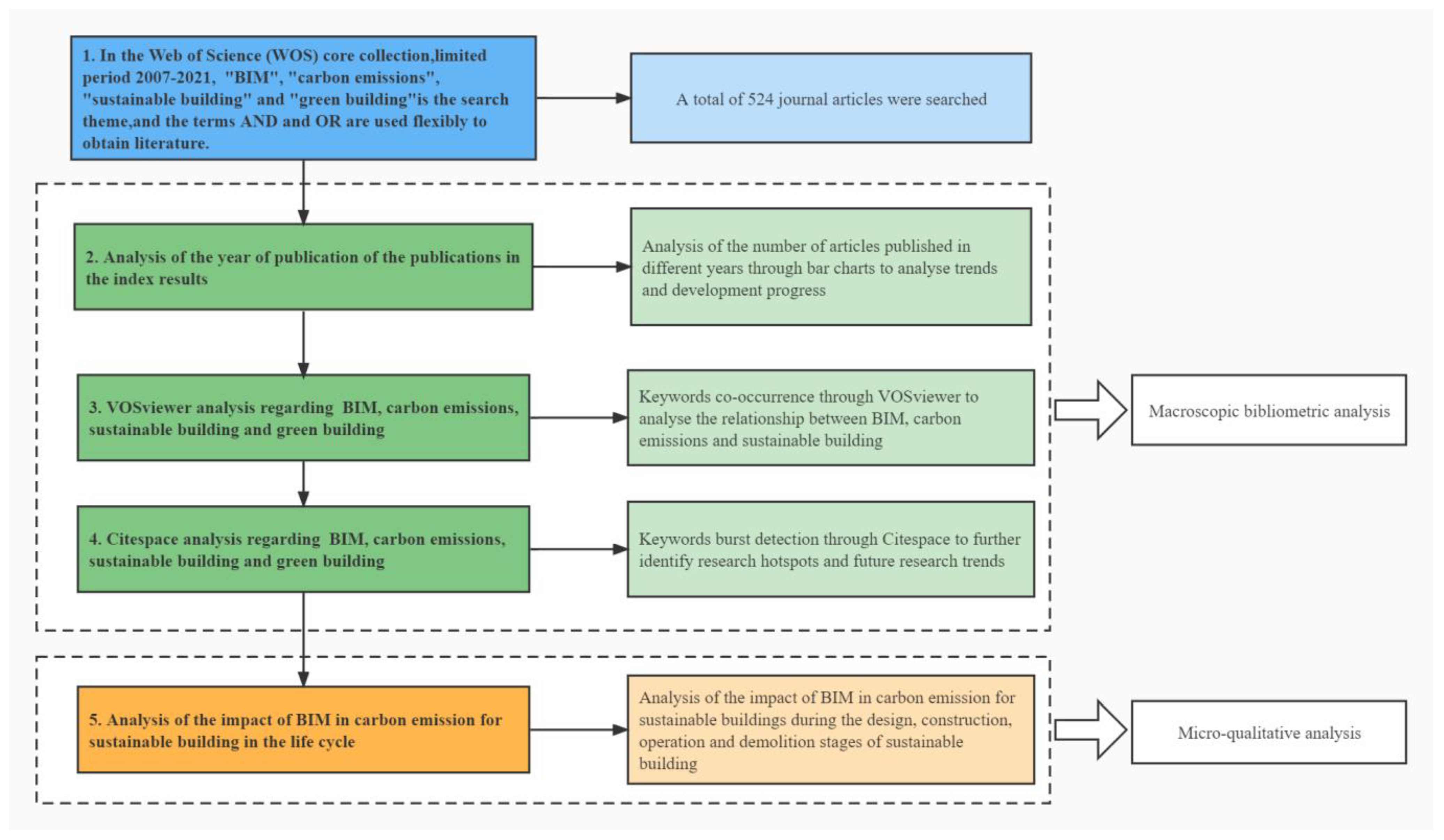
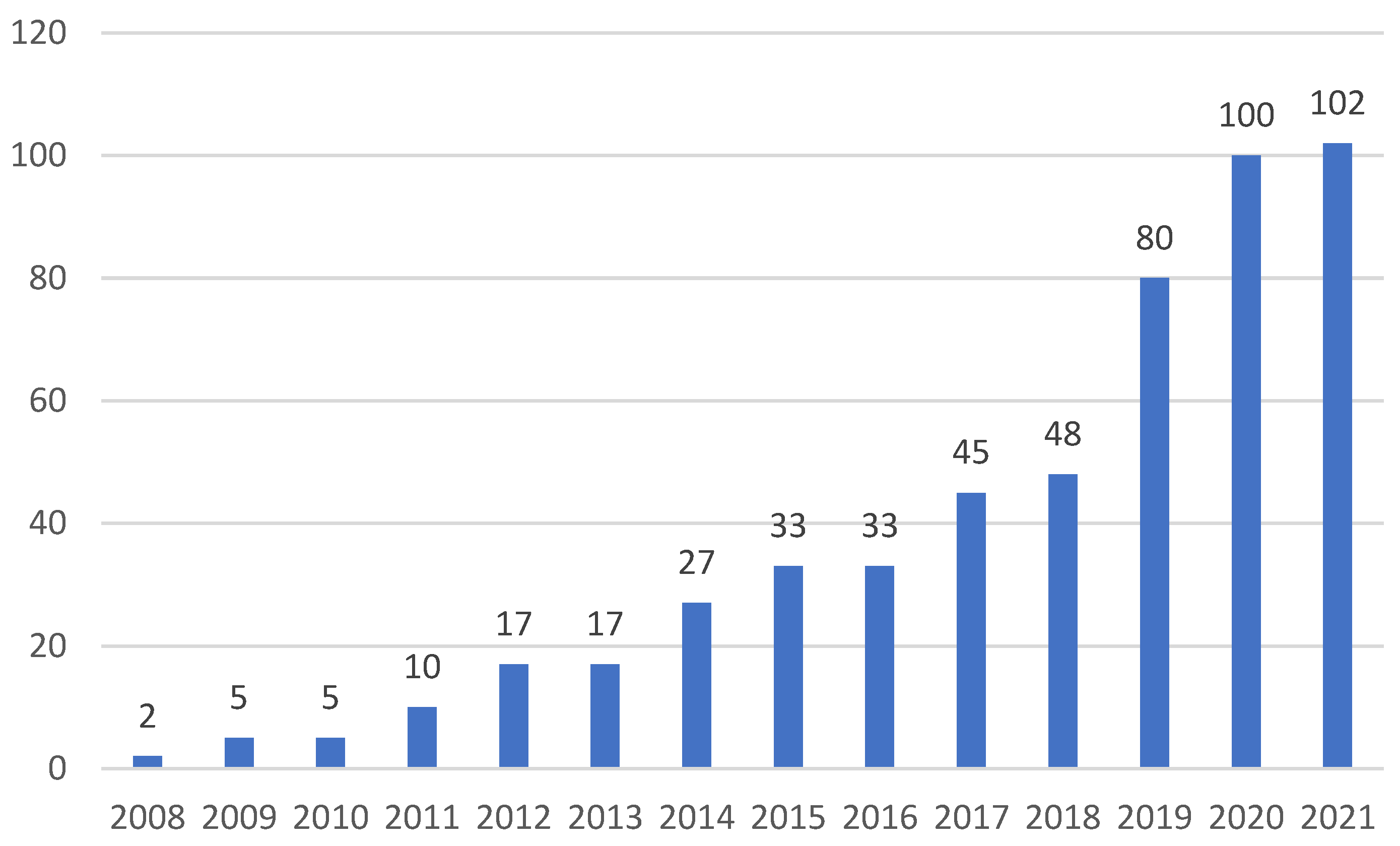
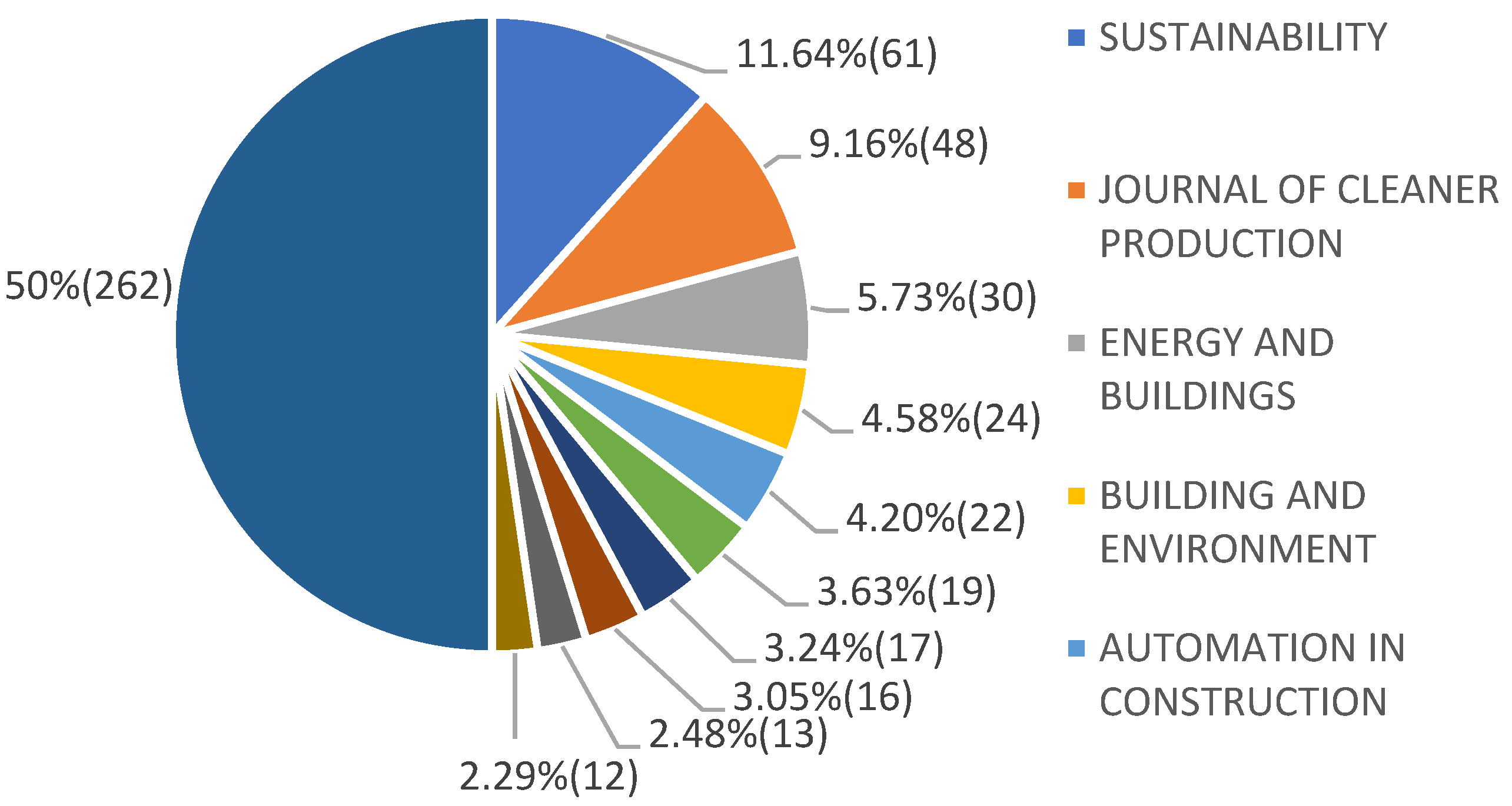
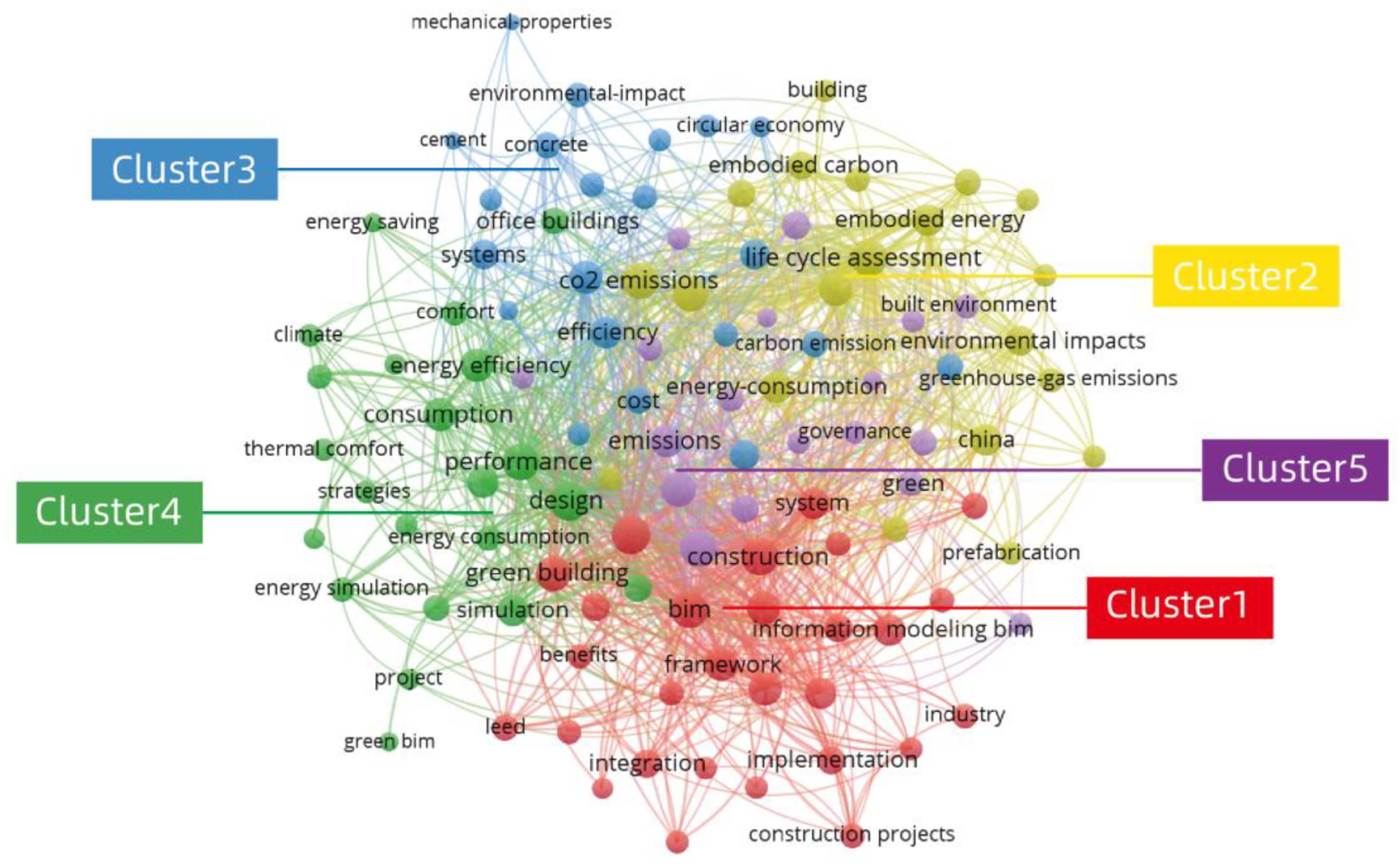
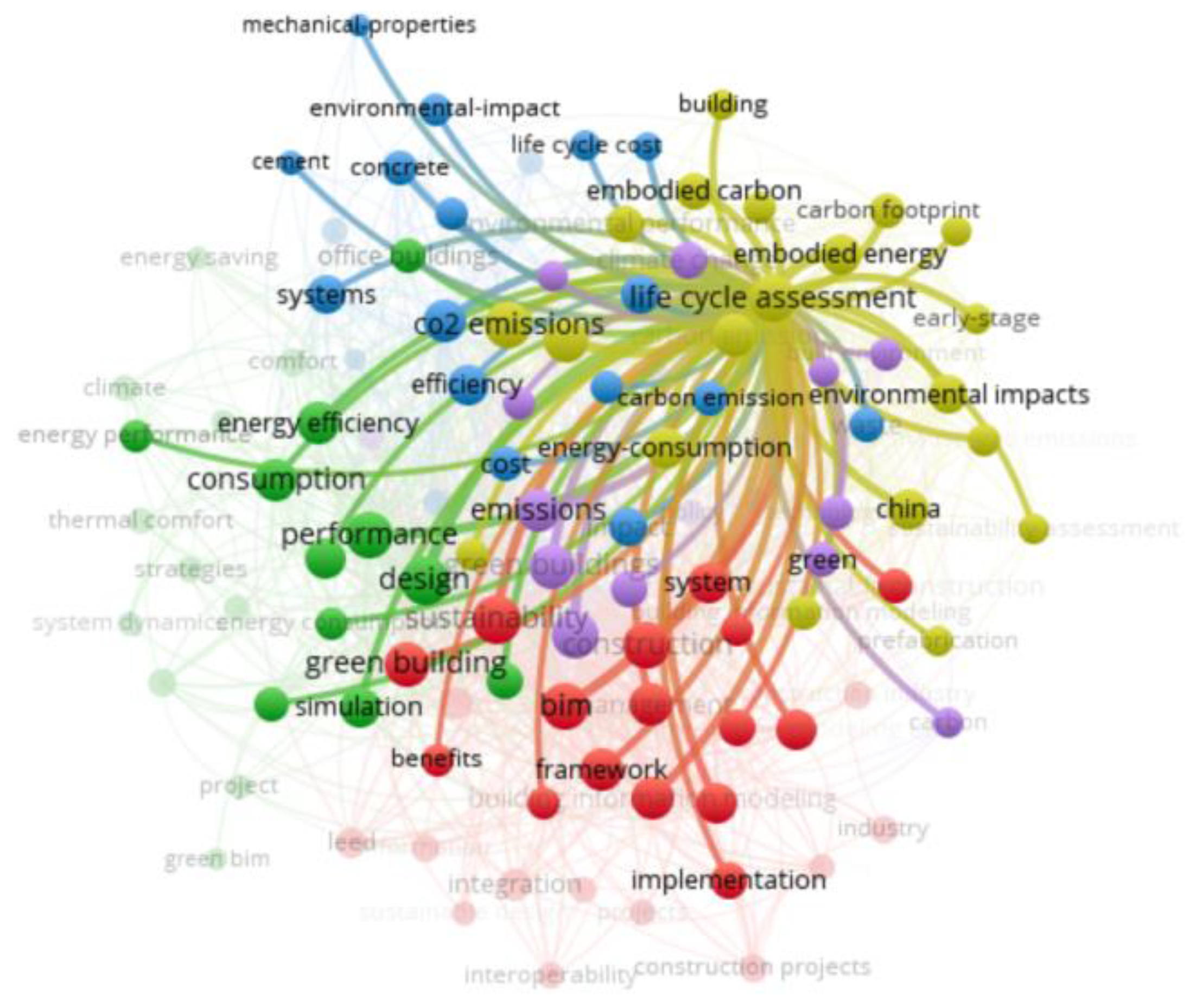
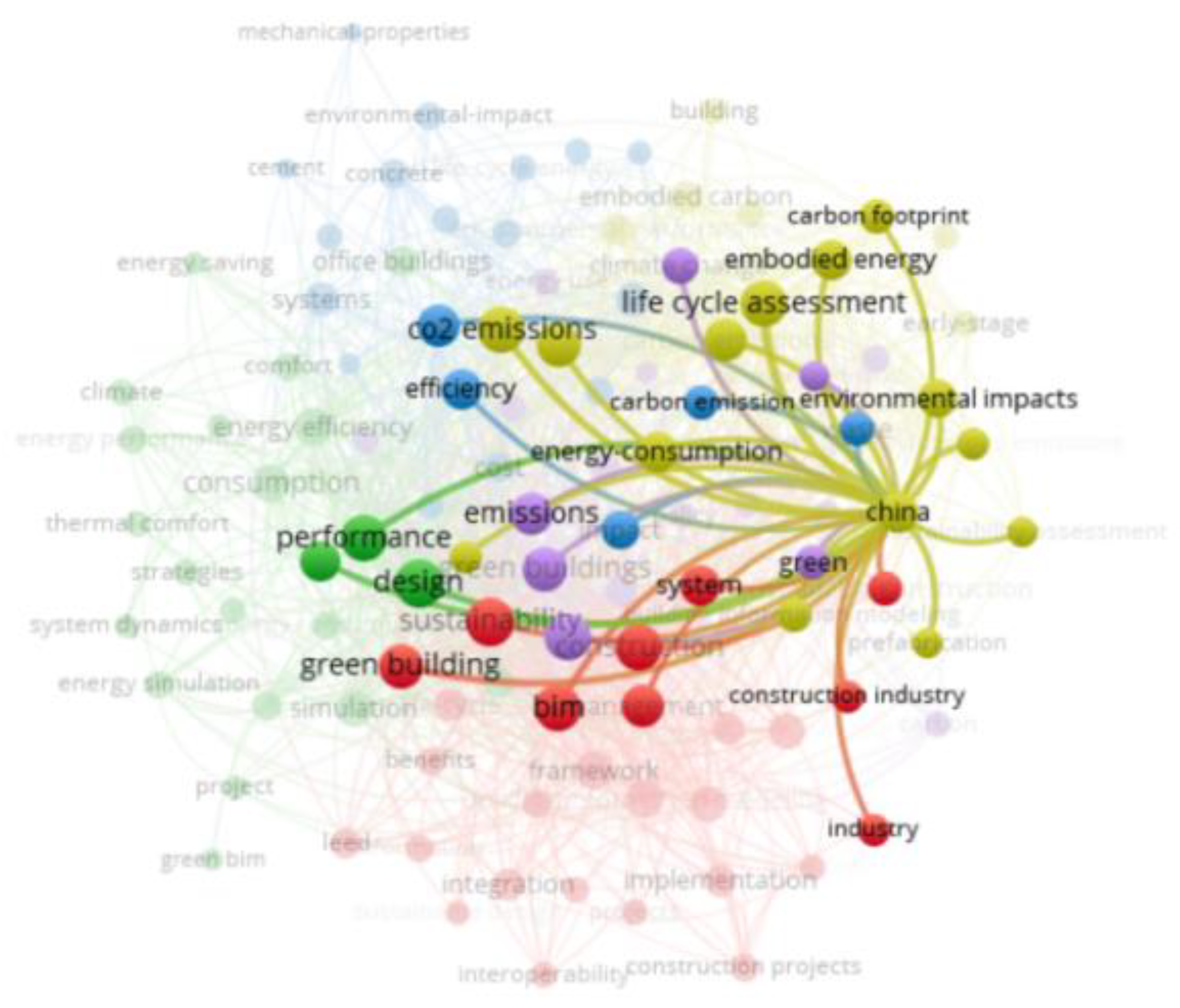
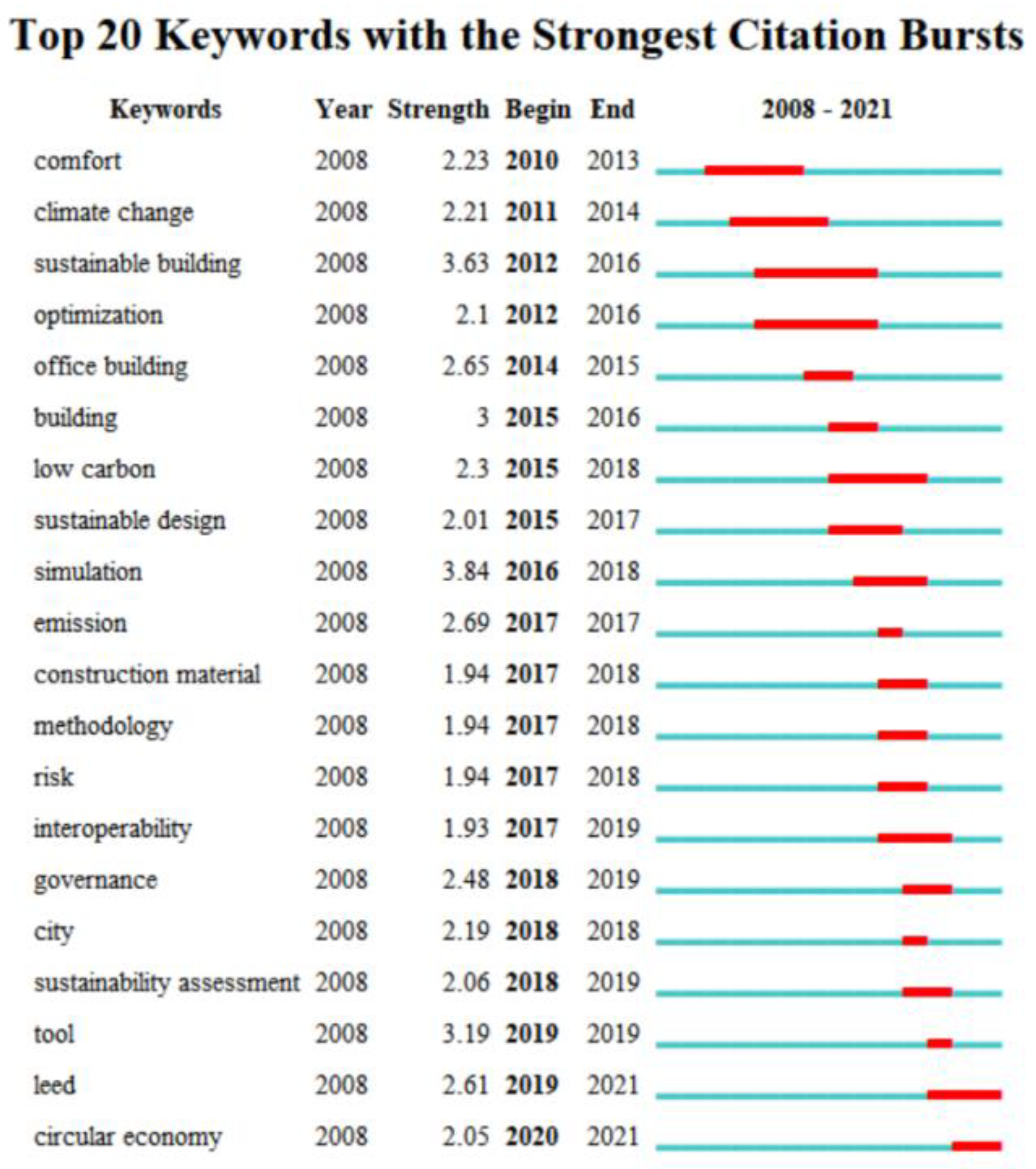
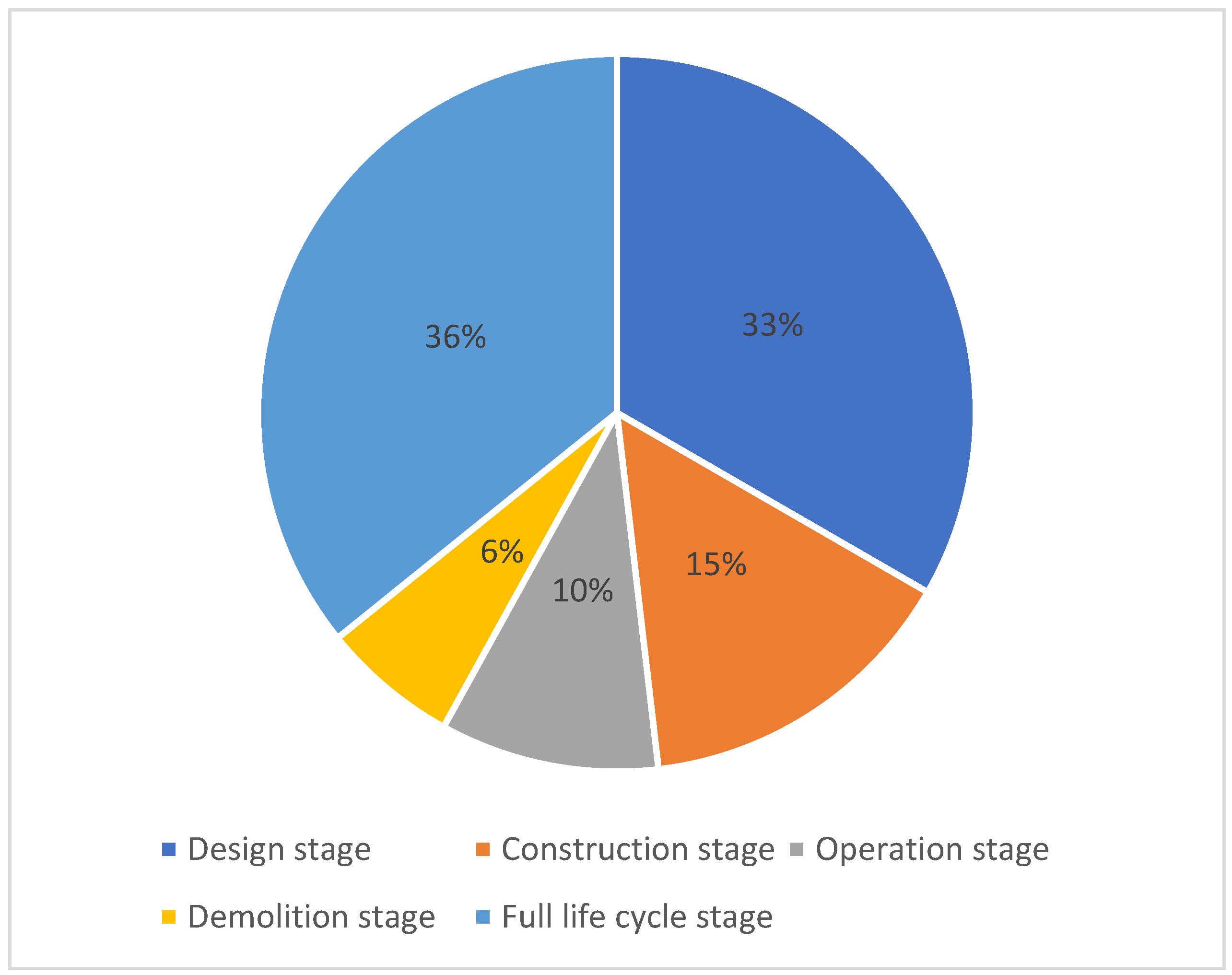
| Color 1 | Cluster | Keyword | Occurrence | Total Link Strength |
|---|---|---|---|---|
| 1 | BIM | 173 | 723 | |
| 2 | Lifecycle Assessment | 103 | 541 | |
| 5 | Green Buildings | 127 | 475 | |
| 4 | Design | 86 | 455 | |
| 1 | Construction | 73 | 411 | |
| 2 | Carbon Emissions | 67 | 369 | |
| 4 | Performance | 76 | 362 | |
| 1 | Sustainability | 71 | 339 | |
| 5 | Energy | 61 | 295 | |
| 2 | Residential Buildings | 41 | 225 |
| Source | Year | Research Method | Research Topic |
|---|---|---|---|
| Barone, G [95] | 2021 | Model and case study | BIM and energy modeling |
| Haruna [96] | 2021 | Questionnaire and modeling | BIM and multicriteria-decision-making (MCDM) integration |
| Marzouk [97] | 2021 | Model and case study | BIM and MCDM integration |
| Khahro [9] | 2021 | Case study | Energy costs and carbon optimization |
| Xue [107] | 2021 | Literature review | Circular economy |
| Carvalho [98] | 2021 | Model and case study | BIM and building-sustainability-assessment (BSA) integration |
| Marrero, M [110] | 2020 | Modeling | Integration of BIM and lifecycle assessment (LCA) |
| Cang, YJ [99] | 2020 | Model and case study | Calculation of implied carbon emissions |
| Jalaei [37] | 2020 | Model and case study | BIM and Leadership in Energy and Environmental Design (LEED) integration |
| Wei [38] | 2020 | Model and case study | Building costs and energy efficiency |
| Galiano-Garrigos [60] | 2019 | Case study | Energy-performance and carbon-footprint assessment |
| Chen, SY [65] | 2019 | Model and case study | Net-zero-energy buildings (NZEBs) |
| Carvalho [100] | 2019 | Case study | BSA |
| Tushar [101] | 2019 | Case study | Energy-consumption optimization |
| Najjar [69] | 2019 | Model and case study | Integration of BIM and LCA |
| Singh [62] | 2019 | Case study | Building energy assessment |
| Eleftheriadis [111] | 2018 | Model and case study | Structural design optimization |
| Lee [61] | 2018 | Case study | Green BIM |
| Eleftheriadis [102] | 2018 | Modeling | Relationship between structural costs and carbon emissions |
| Akcay et al. [112] | 2017 | Model and case study | BIM and LEED integration |
| Chen et al. [106] | 2016 | Model and case study | BIM and MCDM integration |
| Liu et al. [108] | 2015 | Case study | The tradeoff between lifecycle cost (LCC) and lifecycle carbon emissions (LCCEs) |
| Jalaei, F et al. [36] | 2015 | Model and case study | BIM and LEED integration |
| Cemesova et al. [63] | 2015 | Case study | BIM and building-performance-simulation (BPS) integration |
| Jun et al. [35] | 2015 | Modeling | Green BIM template (GBT) |
| Jrade, A et al. [103] | 2013 | Modeling | Integration of BIM and LCA |
| Bank et al. [105] | 2011 | Modeling | BIM and system-dynamics (SD) integration |
| Source | Year | Research Method | New Build | Renovation | Research Topic |
|---|---|---|---|---|---|
| Zhao [64] | 2021 | Modeling | * | NZEBs | |
| Mulero-Palencia [113] | 2021 | Modeling | * | Machine learning | |
| Guo [123] | 2021 | Mixed | * | Green-building assessment and optimization | |
| Piselli [120] | 2020 | Case study | * | Energy renovation of historic buildings | |
| Sun [114] | 2020 | Modeling | * | Calculation of carbon emissions during construction | |
| Chen [115] | 2019 | Modeling | * | Integration of BIM and web-map services (WMSs) | |
| Edwards [119] | 2019 | Review | * | Sustainability decision making | |
| Tzortzopoulos [117] | 2019 | Case study | * | Transformation program assessment | |
| Ozarisoy [118] | 2019 | Model and case study | * | Low-energy design strategies | |
| Hu [121] | 2018 | Model and case study | * | Educational building renovation | |
| Kim [124] | 2017 | Modeling | * | Building energy optimization | |
| Sattary [125] | 2016 | Model and case study | * | Bioclimatic principles |
| Source | Year | Research Method | Research Topic |
|---|---|---|---|
| Venkatraj [134] | 2020 | Mixed | Tradeoffs between embodied and operational energy |
| Cheng [46] | 2020 | Case study | Integration of BIM and LCA |
| Piselli [116] | 2020 | Case study | Application of facility energy management |
| Chen [126] | 2019 | Case study | Workflow design |
| Shadram [127] | 2018 | Model and case study | Tradeoffs between embodied and operational energy |
| Petri [68] | 2017 | Case study | Building operations and energy performance |
| Costa [128] | 2013 | Modeling | Building operations and energy performance |
| Gokce [129] | 2013 | Model and case study | Energy-efficient building operations |
| Source | Year | Research Method | Research Topic |
|---|---|---|---|
| Shi [135] | 2021 | Model and case study | Construction and demolition waste disposal technology |
| Li [137] | 2020 | Review | Construction and demolition waste management |
| Xu [136] | 2019 | Modeling | Greenhouse gas (GHG) emissions |
| Wang [138] | 2018 | Case study | Integration of BIM and LCA |
| Wu [50] | 2014 | Review | GHG emissions from concrete |
| Source | Year | Research Method | Research Topic |
|---|---|---|---|
| Gardezi [139] | 2021 | Model and case study | The relationship between physical characteristics and carbon footprint |
| Marzouk [151] | 2021 | Interviews | BIM and green-building assessment |
| Kurian [51] | 2021 | Modeling | Building carbon-footprint estimation |
| Li [56] | 2021 | Model and case study | Assembled concrete buildings |
| Figueiredo [140] | 2021 | Model and case study | Sustainable-material selection |
| Shukra [16] | 2021 | Review | Holistic green BIM |
| Carvalho [141] | 2020 | Model and case study | Integration of BIM and LCA |
| Fokaides [142] | 2020 | Mixed | Intelligent buildings |
| Dalla Mora [42] | 2020 | Review | Integration of BIM and LCA |
| Kaewunruen [143] | 2020 | Model and case study | Whole-life costs and carbon emissions |
| Wen [144] | 2020 | Mixed | BIM and green-building assessment |
| Montiel-Santiago [152] | 2020 | Model and case study | Sustainability and energy efficiency |
| Pucko [145] | 2020 | Modeling | Building envelope |
| Wang [4] | 2020 | Model and case study | Integration of BIM and LCA |
| Palumbo [48] | 2020 | Model and case study | Integration of BIM and LCA |
| Lu [18] | 2019 | Model and case study | Integration of BIM and LCA |
| Muller [148] | 2019 | Review | Interoperability of BIM |
| Petrova [146] | 2019 | Modeling | Data-driven sustainable design |
| Yang [45] | 2018 | Model and case study | Integration of BIM and LCA |
| Gan [153] | 2018 | Model and case study | A holistic BIM framework for low-carbon design |
| Marzouk [154] | 2017 | Model and case study | GHG calculations |
| Xie [40] | 2017 | Modeling | BIM and carbon calculations |
| Najjar [15] | 2017 | Model and case study | Integration of BIM and LCA |
| GhaffarianHoseini [149] | 2017 | Review | Postconstruction-energy-efficiency testing |
| Lu [57] | 2017 | Model and case study | Integration of BIM and LCA |
| Peng [155] | 2016 | Model and case study | BIM and carbon calculations |
| Abanda [150] | 2016 | Model and case study | The effect of the building orientation on the building energy consumption |
| Wong [13] | 2015 | Review | Green BIM |
| Lee [147] | 2015 | Modeling | BIM green template |
Publisher’s Note: MDPI stays neutral with regard to jurisdictional claims in published maps and institutional affiliations. |
© 2022 by the authors. Licensee MDPI, Basel, Switzerland. This article is an open access article distributed under the terms and conditions of the Creative Commons Attribution (CC BY) license (https://creativecommons.org/licenses/by/4.0/).
Share and Cite
Liu, Z.; Li, P.; Wang, F.; Osmani, M.; Demian, P. Building Information Modeling (BIM) Driven Carbon Emission Reduction Research: A 14-Year Bibliometric Analysis. Int. J. Environ. Res. Public Health 2022, 19, 12820. https://doi.org/10.3390/ijerph191912820
Liu Z, Li P, Wang F, Osmani M, Demian P. Building Information Modeling (BIM) Driven Carbon Emission Reduction Research: A 14-Year Bibliometric Analysis. International Journal of Environmental Research and Public Health. 2022; 19(19):12820. https://doi.org/10.3390/ijerph191912820
Chicago/Turabian StyleLiu, Zhen, Peixuan Li, Fenghong Wang, Mohamed Osmani, and Peter Demian. 2022. "Building Information Modeling (BIM) Driven Carbon Emission Reduction Research: A 14-Year Bibliometric Analysis" International Journal of Environmental Research and Public Health 19, no. 19: 12820. https://doi.org/10.3390/ijerph191912820
APA StyleLiu, Z., Li, P., Wang, F., Osmani, M., & Demian, P. (2022). Building Information Modeling (BIM) Driven Carbon Emission Reduction Research: A 14-Year Bibliometric Analysis. International Journal of Environmental Research and Public Health, 19(19), 12820. https://doi.org/10.3390/ijerph191912820











